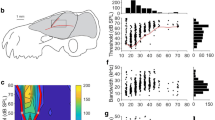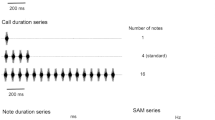Summary
-
1.
In the rufous horseshoe bat,Rhinolophus rouxi, responses to pure tones and sinusoidally frequency modulated (SFM) signals were recorded from 289 single units and 241 multiunit clusters located in the nuclei of the lateral lemniscus (NLL).
-
2.
The distribution of best frequencies (BFs) of units in all three nuclei of the lateral lemniscus showed an overrepresentation in the range corresponding to the constant-frequency (CF) part of the echolocation signal (‘filter frequency’ range): in the ventral nucleus of the lateral lemniscus (VNLL) ‘filter neurons’ represented 43% of all units encountered, in the intermediate nucleus (INLL) 33%, and in dorsal nucleus (DNLL) 29% (Fig. 2a). Neurons with best frequencies in the filter frequency range had highest Q10dB-values (maxima up to 400, Fig. 2c) and only in low-frequency units were values comparable to those found in other mammals. On the average, filter neurons in ventral nucleus had higher Q10dB-values (about 220) than did those in intermediate and dorsal nucleus (both about 160, Fig. 2d).
-
3.
Response patterns and tuning properties showed higher complexity in the dorsal and intermediate nucleus than in the ventral nucleus of the lateral lemniscus (Figs. 4 and 6). Multiple best frequencies were found in 12 neurons, nine of them with harmonically related excitation maxima (Fig. 5c, d). Best frequencies of six of these harmonically tuned units could not be correlated with any harmonic components of the echolocation signal. Half of all multiple tuned neurons were located in the caudal dorsal nucleus the other half in the caudal intermediate nucleus.
-
4.
Synchronization of responses to sinusoidally frequency modulated (SFM) signals occurred in VNLL-units in the average up to modulation frequencies of 515 Hz (maximum about 800 Hz) whereas in the intermediate and dorsal nucleus of the lateral lemniscus responses were synchronized in the average only up to modulation frequencies of about 300 Hz (maximum about 600 Hz) (Figs. 7 and 8).
-
5.
A tonotopic arrangement of units was found in the intermediate nucleus of the lateral lemniscus with units having high best frequencies located medially and those with low best frequencies laterally. In the dorsal nucleus the tonotopic distribution was found to be fairly similar to that in the intermediate nucleus but much less pronounced. In more rostral parts of the dorsal nucleus additionally higher best frequencies predominated whereas in caudal areas of that nucleus and also of the intermediate nucleus low BFs were found more regularly. The ventral nucleus of the lateral lemniscus was characterized by a remarkably high proportion of neurons having best frequencies in the filter frequency range. In fact, the entire lateral, central and dorsomedial parts were devoted to the representation of the filter frequency. Lower best frequencies were present only in the medial parts of the ventral nucleus of the lateral lemniscus (Fig. 9).
Similar content being viewed by others
Abbreviations
- BF :
-
best frequency
- CF :
-
constant frequency component of the echolocation signal
- CN :
-
cochlear nucleus
- IC :
-
inferior colliculus
- FM :
-
frequency modulated component of the echolocation signal
- NLL :
-
nuclei of the lateral lemniscus
- DNLL :
-
dorsal NLL
- INLL :
-
intermediate NLL
- VNLL :
-
ventral NLL
- RF :
-
resting frequency of the echolocation sound
- SFM :
-
sinusoidally frequency modulated
- SOC :
-
superior olivary complex
References
Aitkin LM, Anderson DJ, Brugge JF (1970) Tonotopic organisation and discharge characteristics of neurons in nuclei of the lateral lemniscus of the cat. J Neurophysiol 33:421–440
Brugge JF, Anderson DJ, Aitkin LM (1970) Responses of neurons of the dorsal nucleus of the lateral lemniscus of cat to binaural tonal stimulation. J Neurophysiol 33:441–458
Brunso-Bechthold JK, Thompson GC, Masterton RB (1981) HRP study of the organisation of auditory afferents to central nucleus of inferior colliculus in cat. J Comp Neurol 197:705–722
Feng A, Vater M (1985) Functional organization of the cochlear nucleus of Rufous Horseshoe Bats (Rhinolophus rouxi): frequencies and internal connections are arranged in slabs. J Comp Neurol 235:529–555
Guinan JJ, Guinan SS, Norris BE (1972a) Single auditory units in the superior olivary complex. I. Responses to sounds and classifications based on physiological properties. Int J Neurosci 4:101–120
Guinan JJ, Guinan SS, Norris BE (1972b) Single auditory units in the superior olivary complex. II. Location of unit categories and tonotopic organization. Int J Neurosci 4:147–166
Glendenning KK, Thompson GC, Masterton RB (1981) Ascending auditory afferents to the nuclei of the lateral lemniscus. J Comp Neurol 197:673–703
Konstantinov A (1973) Development of echolocation in bats in postnatal ontogenesis. Period Biol 75:13–19
Matsumura S (1979) Mother-infant communication in a horseshoe bat (Rhinolophus ferrumequinum Nippon): development of echolocation. J Mammal 60:76–84
Matsumura S (1981) Mother-infant communication in a horseshoe bat (Rhinolophus ferrumequinum Nippon): vocal communication in three-week-old infants. J Mammal 62:20–28
Möller J, Neuweiler G, Zöller H (1978) Response characteristics of inferior colliculus neurons of awake CF-FM batRhinolophus ferrumequinum. I. Single tone stimulation. J Comp Physiol 125:217–225
Neuweiler G, Vater M (1977) Response patterns to pure tones of cochlear nucleus units in the CF-FM batRhinolophus ferrumequinum. J Comp Physiol 115:119–133
Neuweiler G, Bruns V, Schuller G (1980) Ears adapted for the detection of motion, or how echolocating bats exploited the capacities of the mammalian auditory system. J Acoust Soc Am 68:741–753
Neuweiler G, Metzner W, Heilmann U, Rübsamen R, Costa HH (1987) Foraging behaviour and echolocation in the rufous horseshoe bat (Rhinolophus rouxi) of Sri Lanka. Behav Ecol Sociobiol 20:53–67
O'Neill WE, Suga N (1982) Encoding of target range and its representation in the auditory cortex of the mustache bat. J Neurosci 2:17–31
O'Neill WE, Schuller G, Radtke-Schuller S (1985) Functional and anatomical similarities in the auditory cortices of the old world horseshoe bat and neotropical mustache bat for processing of similar biosonar signals. Abstract of the 8th meeting of the Association for research of otolaryngology, 193
Ostwald J (1984) Tonotopical organization and pure tone response characteristics of single units in the auditory cortex of the Greater Horseshoe Bat. J Comp Physiol A 155:821–834
Pfeiffer RR (1966) Classification of response patterns of spike discharges for units in the cochlear nucleus. Exp Brain Res 1:220–235
Pollak GD, Bodenhamer R (1981) Specialized characteristics of single units in the inferior colliculus of mustache bat: frequency representation, tuning, and discharge patterns. J Neurophysiol 46:605–620
Pollak GD, Schuller G (1981) Tonotopic organization and encoding features of single units in the inferior colliculus of horseshoe bats: functional implications for prey identification. J Neurophysiol 45:208–226
Roth GL, Aitkin LM, Anderson RA, Merzenich MM (1978) Some features of the spatial organization of the central nucleus of the inferior colliculus of the cat. J Comp Neurol 182:661–680
Schnitzler HU (1968) Die Ultraschallortungslaute der Hufeisenfledermäuse in verschiedenen Orientierungssituationen. Z Vergl Physiol 57:376–408
Schnitzler HU, Menne D, Kober R, Heblich K (1983) The acoustical image of fluttering insects in echolocating bats. In: Huber F, Markl H (eds) Neuroethology and behavioral physiology. Springer, Berlin Heidelberg New York Tokyo, pp 235–250
Schnitzler HU, Hackbarth H, Heilmann U, Herbert H (1985) Echolocation behavior of rufous horseshoe bats hunting for insects in the flycatcher-style. J Comp Physiol A 157:39–46
Schuller G (1979a) Coding of small sinusoidal frequency and amplitude modulations in the inferior colliculus of the CF-FM batRhinolophus ferrumequinum. Exp Brain Res 34:117–132
Schuller G (1979b) Vocalization influences auditory processing in collicular neurons of the CF-FM bat,Rhinolophus ferrumequinum. J Comp Physiol 132:39–46
Schuller G (1980) Hearing characteristics and Doppler shift compensation in South Indian CF-FM bats. J Comp Physiol 139:349–356
Schuller G (1984) Natural ultrasonic echoes from wing beating insects are encoded by collicular neurons in the CF-FM bat,Rhinolophus ferrumequinum. J Comp Physiol A 155:121–128
Schuller G, Pollak G (1979) Disproportionate frequency representation in the inferior colliculus of Doppler-compensating greater horseshoe bats: evidence for an acoustic fovea. J Comp Physiol 132:47–54
Schuller G, Radtke-Schuller S, Betz M (1986) A stereotaxic method for small animals using experimentally determined reference profiles. J Neurosci Meth 18:339–350
Schweizer H (1981) The connections of the inferior colliculus and the organization of the brainstem auditory system in the greater horseshoe batRhinolophus ferrumequinum. J Comp Neurol 201:25–49
Suga N, Schlegel P (1972) Neural attenuation of responses to emitted sounds in echolocating bats. Science 177:82–84
Suga N, Schlegel P (1973) Coding and processing in the auditory system of FM-signal-producing bats. J Acoust Soc Am 54:174–190
Suga N, Jen PH-S (1976) Disproportionate tonotopic representation for processing CF-FM sonar signals in the mustached bat's auditory cortex. Science 194:542–544
Suga N, Neuweiler G, Möller J (1976) Peripheral auditory tuning for fine frequency analysis by the CF-FM batRhinolophus ferrumequinum. IV. Properties of peripheral auditory neurons. J Comp Physiol 106:111–125
Tanaka K, Otani K, Tokunaga A, Sugita S (1985) The organization of neurons in the nucleus lemniscus projecting to the superior and inferior colliculi in the rat. Brain Res 341:252–260
Vater M (1982) Single unit responses in cochlear nucleus of horseshoe bats to sinusoidal frequency and amplitude modulated signals. J Comp Physiol 149:369–388
Willard FH, Ryugo DK (1983) Anatomy of the central auditory system. In: Willot JF (ed) The auditory psychobiology of the mouse. Clark C Thomas Publishers, Springfield/Illinois, pp 201–304
Whitley JM, Henkel CK (1984) Topographical organization of the collicular projection and other connections of the ventral nucleus of the lateral lemniscus in the cat. J Comp Neurol 229:257–270
Zook JM, Casseday JH (1982a) Cytoarchitecture of auditory system in lower brainstem of mustache batPteronotus parnellii. J Comp Neurol 207:1–13
Zook JM, Casseday JH (1982b) Origin of ascending projections to inferior colliculus in the mustache batPteronotus parnellii. J Comp Neurol 207:14–28
Zook JM, Casseday JH (1985) Projections from the cochlear nucleus in the mustache bat,Pteronotus parnellii. J Comp Neurol 237:307–324
Zook JM, Winer JA, Pollak GD, Bodenhamer RD (1985) Topology of the central nucleus of the mustache bat's inferior colliculus: correlation of single unit properties and neuronal architecture. J Comp Neurol 231:530–546
Author information
Authors and Affiliations
Rights and permissions
About this article
Cite this article
Metzner, W., Radtke-Schuller, S. The nuclei of the lateral lemniscus in the rufous horseshoe bat,Rhinolophus rouxi . J. Comp. Physiol. 160, 395–411 (1987). https://doi.org/10.1007/BF00613029
Accepted:
Issue Date:
DOI: https://doi.org/10.1007/BF00613029




